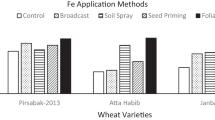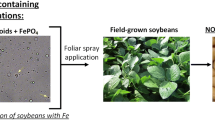Abstract
Direct seeded aerobic rice (DSR) is an emerging production system in Asia due to declining water availability and labor scarcity. Iron (Fe) deficiency is a severe problem in DSR as Fe2+ oxidized to Fe3+ and become unavailable to plants. Seed treatment is one of the emerging approaches to deal with Fe deficiency and content in rice crop to compensate this issue. Hence, pot experiment was planned in randomized block design to study the effect of Fe seed priming through different sources, i.e., iron sulfate (FeSO4.7H2O), Chelated iron (Fe-EDTA) and nano iron (FeONPs) and their levels on yield and Fe content in direct seeded aerobic rice (variety PR 126) under sandy loam and silt loam soils with three replications. On an average, seed priming with FeSO4.7H2O solution (1.0% Fe) showed the highest increase in grain yield (12.7%) over the control. On the other hand, increasing dose of Fe from 0.5 to 1.0% through Fe-EDTA showed adverse effects on rice yield due to higher residual effects. The plant height and chlorophyll content in rice plants varied from 26.1 to 42.2 cm and from 30.9 to 35.1 as SPAD value with maximum content in treatment having FeSO4.7H2O (0.5%Fe) in both the soils. The total and ferrous Fe content in rice plants ranged from 42.7 to 62.2 mg kg−1 and from 35.8 to 41.0 in harvested grains with the highest content in treatment having Fe-EDTA (0.5%Fe) followed by treatment FeSO4.7H2O (1.0%Fe) and treatment Fe-EDTA (0.25%Fe), respectively. Thus, seed priming of rice with 1.0%Fe solution using FeSO4.7H2O can be used for further studies to reduce Fe malnutrition in global population.


Similar content being viewed by others
Data availability
Data will be available on demand.
References
Adhikary S, Biswas B, Chakraborty D, Timsina D, Pal S, Tarafdar JC, Banerjee S, Hossain A, Roy S (2022) Seed priming with selenium and zinc nanoparticles modifies germination, growth, and yield of direct-seeded rice (Oryza sativa L.). Sci Rep 12:7103
Al-Amri N, Tombuloglu H, Slimani Y, Akhtar S, Barghouthi M, Almessiere M, Alshammari T, Baykal A, Sabit H, Ercan I, Ozcelik S (2020) Size effect of iron (III) oxide nanomaterials on the growth, and their uptake and translocation in common wheat (Triticum aestivum L.). Ecotoxicol Environ Saf 194:110377
Alhendawi RA, Kirkby EA, Pilbeam DJ, Romheld V (2008) Effect of iron seed dressing and form of nitrogen-supply on growth and micronutrient concentration in shoots of sorghum grown in a calcareous sand culture. J Plant Nutr 31:1855–1865
Bhardwaj AK, Chejara S, Malik K, Kumar R, Kumar A, Yadav RK (2022) Agronomic biofortification of food crops: An emerging opportunity for global food and nutritional security. Front Plant Sci 13:1055278
Chaudhary A, Venkatramanan V, Kumar Mishra A, Sharma S (2023) Agronomic and environmental determinants of direct seeded rice in South Asia. Circ Econ Sust 3:253–290
Chen Y, Barak P (1982) Iron nutrition of plants in calcareous soils. Adv Agron 35:217–240
Dhaliwal SS, Sharma V, Shukla AK, Kaur M, Kaur J, Verma V, Singh P, Barek V, Gaber A, Hossain A (2023) Biofortification of mungbean (Vigna radiata L. (Wilczek)) with boron, zinc and iron alters its grain yield and nutrition. Sci Rep 13:3506
Dhaliwal SS, Shukla AK, Sharma V, Behera SK, Choudhary OP, Chaudhari SK, Prakash C, Kumar A, Patra AK, Sikaiya Y, Tripathi (2020) Status of sulphur and micronutrients in soils of Punjab. Pp. 1–210. Department of Soil Science, Punjab Agricultural University, Ludhiana and ICAR-Indian Institute of Soil Science, Bhopal, India.
Espirito Santo Pereira A, Caixeta Oliveira H, Fernandes Fraceto L, Santaella C (2021) Nanotechnology potential in seed priming for sustainable agriculture. Nanomaterials 11:267
Fan X, Karim MR, Chen X, Zhang Y, Gao X, Zhang F, Zou C (2012) Growth and iron uptake of lowland and aerobic rice genotypes under flooded and aerobic cultivation. Commun Soil Sci Plant Anal 43:1811–1822
FAO (2017) Rice production, utilization and stocks. Rice Market Monitor 20: 1-35
Farooq M, Wahid A, Siddique KH (2012) Micronutrient application through seed treatments: a review. J Soil Sci Plant Nutr 12:125–142
Fukai S, Mitchell J (2022) Factors determining water use efficiency in aerobic rice. Crop Environ 1(1):24–40
Gill JS, Walia SS (2013) Effect of foliar application of iron, zinc and manganese on direct seeded aromatic rice (Oryza sativa). Indian J Agron 59:80–85
Goiba PK, Durgude A, Pharande A, Kadlag A, Chauhan M, Nimbalkar C (2018) Effect of seed priming with iron and zinc on yield contributing parameters as well as the nutrient uptake of the soybean (Glycine max) in calcareous soil. Int J Chem Stud 6:758–760
Guha T, Ravikumar KVG, Mukherjee A, Mukherjee A, Kundu R (2018) Nanopriming with zero valent iron (nZVI) enhances germination and growth in aromatic rice cultivar (Oryza sativa cv. Gobindabhog L.). Plant Physiol Biochem 127:403–413
Jackson ML (1973) Soil chemical analysis-Advance Course. A manual of methods useful for instruction and research in soil chemistry, physical chemistry, soil fertility and soil genesis. 2nd edition, Madison, US.
Katyal JC, Sharma BD (1980) A new technique of plant analysis to resolve iron chlorosis. Plant Soil 55:105–119
Katyal JC, Sharma BD (1984) Association of soil properties and plant iron to iron deficiency response in rice (Oryza sativa L.). Commun Soil Sci Plant Anal 15:1065–1081
Kayatz B, Harris F, Hillier J, Adhya T, Dalin C, Nayak D, Dangour AD (2019) More crop per drop: exploring India’s cereal water use since 2005. Sci Total Environ 673:207–227
Khan TA, Ahmed ZI, Syed S, Baloch A, Malik MN, Irfan M, Hussain SM (2017) Seed priming with iron and zinc improves growth and yield of groundnut (Arachis hypogaea L.). Pure Appl Biol 6:553–560
Lindsay WL, Norvell WA (1978) Development of a DTPA soil test for zinc, iron, manganese and copper. Soil Sci Soc America J 42:421–428
Mahender A, Swamy BPM, Anandan A, Ali J (2019) Tolerance of iron-deficient and toxic soil conditions in rice. Plants J 8:1–31
Mallareddy M, Thirumalaikumar R, Balasubramanian P, Naseeruddin R, Nithya N, Mariadoss A, Eazhilkrishna N, Choudhary AK, Deiveegan M, Subramanian E, et al. (2023) Maximizing water use efficiency in rice farming a comprehensive review of innovative irrigation management technologies. Water, 15(10), 1802.
Mamun AA, Naher UA, Ali MY (2018) Effect of seed priming on seed germination and seedling growth of modern rice (Oryza sativa L.) varieties. Agriculturists 16:34–43
Marthandan V, Geetha R, Kumutha K, Renganathan VG, Karthikeyan A, Ramalingam J (2020) Seed priming: a feasible strategy to enhance drought tolerance in crop plants. Int J Mol Sci 21(21):8258. https://doi.org/10.3390/ijms21218258
Meena BL, Rattan RK, Datta SP (2013) Efficacy of seed treatment in ameliorating iron deficiency in aerobic rice on a calcareous soil. J Indian Soc Soil Sci 61:147–152
Merwin HD, Peech M (1950) Exchangeability of soils potassium in the sand, silt and clay fractions as influenced by the nature of the complementary exchangeable cations. Soil Sci Soc America Proc 15:125–128
Mortvedt JJ, Giordano PM (1971) Response of grain sorghum to iron sources applied alone or with fertilizers. Agronomy 63:758–776
Nair KPM, Augustine LF (2018) Country-specific nutrient requirements and recommended dietary allowance for Indians: current status and future directions. Indian J Med Res 148:522–530
Narayanareddy AB, Biradarpatil NK (2012) Effect of pre-sowing invigoration seed treatments on seed quality and crop establishment in sunflower hybrid KBSH-1. J Agric Sci 25:43–46
Olsen SR, Cole CV, Watanabe FS, Dean LA (1954) Estimation of available phosphorus by extraction with sodium bicarbonate. US Deptt Agric Circ 939:1–19
Piper CS (1966) Soil and plant analysis. International Science publishers Inc., New York
Preethi S, Gurusamy A, Subramanian E, Indirani R (2020) Screening of rice cultures and mitigation of iron deficiency in aerobic rice. Int J Chem Stud 8:2272–2274
Rattan RK, Datta SP, Katyal JC (2008) Micronutrient management: research achievements and future challenges. Indian J Fert 4:103–106
Rawashdeh HM, Sala F (2014) Influence of iron foliar fertilization on some growth and physiological parameters of wheat at two growth stages. Romania Sci Pap Ser A Agron 57:306–309
Reddy VS, Palika R, Ismail A, Pullakhandam R, Reddy GB (2018) Nutrigenomics: Opportunities & challenges for public health nutrition. Indian J Med Res 148:632–641
Rout GR, Sahoo S (2015) Role of iron in plant growth and metabolism. Rev Agric Sci 3:1–24
Santos RSD, Araujo ATD, Pegoraro C, Oliveira ACD (2017) Dealing with iron metabolism in rice: From breeding for stress tolerance to biofortification. Genet Mol Biol 40:312–325
Shukla AK, Behera SK (2020) Biofortification for overcoming zinc and iron malnutrition in Indian population: current research status and way forward. Indian J Fert 16:1262–1276
Shukla AK, Behra SK (2019) All India coordinated research project on micro- and secondary nutrients and pollutant elements in soils and plants: research achievements and future thrusts. Indian J Fert 15:522–543
Subbiah BV, Asija GL (1956) A rapid procedure for estimation of available nitrogen in soils. Curr Sci 25:259–260
Sumner ME, Miller WP (1996). Cation exchange capacity and exchange coefficients. In DL Sparks, AL Page, PA Helmke, & RH Loeppert (Eds.), Methods of soil analysis. Part 3. Chemical analysis (pp. 1201–1229). Madison, WI: SSSA and ASSA.
Walkley A, Black CA (1934) An examination of the Degtjareff method for determining soil organic matter and a proposed modification of the chromic acid titration method. Soil Sci 37:1367–1378
Yadav GS, Shivay YS, Kumar D, Babu S (2013) Enhancing iron density and uptake in grain and straw of aerobic rice through mulching and rhizo-foliar fertilization of iron. Afr J Agric Res 8:5447–5454
Acknowledgements
The authors are thankful to the Punjab Agricultural University, Ludhiana, India for providing necessary facilities during the research work.
Funding
This work was supported by ICAR Indian Institute of Soil Science Bhopal.
Author information
Authors and Affiliations
Corresponding author
Ethics declarations
Conflict of interest
The authors declare no competing interests.
Additional information
Communicated by Janusz Zimny.
Rights and permissions
Springer Nature or its licensor (e.g. a society or other partner) holds exclusive rights to this article under a publishing agreement with the author(s) or other rightsholder(s); author self-archiving of the accepted manuscript version of this article is solely governed by the terms of such publishing agreement and applicable law.
About this article
Cite this article
Sharma, V., Kharb, V., Verma, V. et al. Comparative potential of different Fe sources for seed priming to enhance yield and iron content in direct seeded aerobic rice. CEREAL RESEARCH COMMUNICATIONS (2024). https://doi.org/10.1007/s42976-024-00503-9
Received:
Accepted:
Published:
DOI: https://doi.org/10.1007/s42976-024-00503-9




